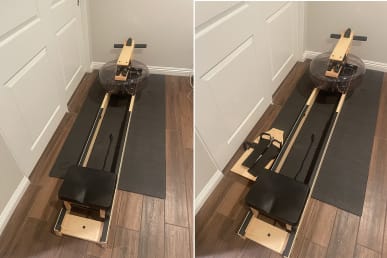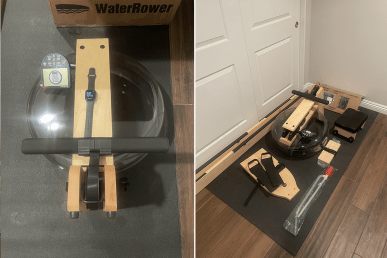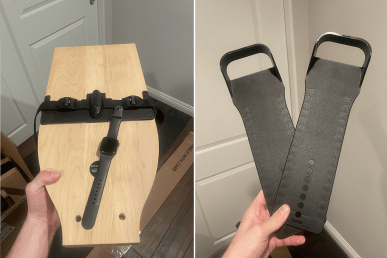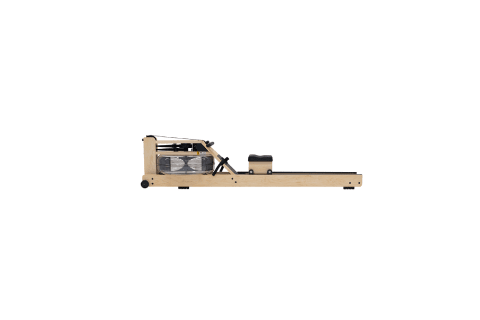Advertisement
I Replaced Running With The WaterRower S4 — But Is It Worth $1,599?


My workout routine started to feel stagnant last year, and I knew my body and mind needed a new challenge. As a regular runner and lifter, I wanted to expand my horizon to explore new types of exercise—which led me to the Johnson Fitness & Wellness WaterRower S4.
Once deemed the "ultimate challenge to the human body," rowing stands out as a low-impact workout that engages your full-body. Eager to see the effect it could have on both my strength and cardiovascular health, I ditched running outdoors for four 20-minute sessions per week on the WaterRower.
Now I consider rowing an essential part of my routine, and I've even increased my endurance and resistance with regular training. Here's my honest take on whether the Johnson Fitness & Wellness WaterRower S4 is worth the $1,599 price tag.
WaterRower S4 by Johnson Fitness & Wellness
- Water resistance feels like rowing on actual water with this unit designed to have 5 levels of resistance based on how much water is in the tank.
- The maple frame looks more luxurious than a metal frame and feels more like an extension of my home decor rather than an imposition on my space.
- The built-in performance monitor tracks your workout to provide feedback on speed and distance. You can also opt into programmed workouts.
- Water tank system makes it harder to adjust resistance between users, and the seat requires manual adjustment to fit people of different heights—making this machine harder to share.
- A closed water tank allows you to store this machine perpendicular without fear of water spills. It also requires maintenance from a water purifier tablet every 6 months.
Who is Johnson Fitness & Wellness?
The brand describes itself as the "home of fitness"—and I'd be hard-pressed to argue otherwise. Founded in 1995, the fitness manufacturing company develops a range of fitness products, including cardio equipment, weights, smart fitness mirrors, and even weight storage solutions.
While you might be less familiar with the name Johnson Fitness, the brand is responsible for quite a few sub-brands with notable recognition, including Horizon treadmills, Matrix club cardio equipment, and Synca massage chairs.
I like to think of Johnson as the perfect value opportunity; it's more affordable than luxury competitors like Peloton but offers a high quality product with more features than competitors like Sunny Health & Fitness.
A rundown on the WaterRower S4
Johnson Fitness & Wellness offers a handful of different water resistance rowers, which all work with the same water tank mechanism. Pulling on the handlebar moves pedals in the tank, which meet resistance against the water. This creates the smooth glide down and back along the steel track—along with a audible wooshing sound.
The water rowers have either a powder coated aluminum or wood frame. I was given a sample of the latter, which comes in a variety of different woods and finishes, including ash, cherrywood, and maple.
Depending on the wood selected, the price varies slightly. My maple frame brought the price up to $1,599 but gives the rower a lighter finish that better suits a modern, minimalist aesthetic. Ultimately, the wood preference comes down to personal taste.
Beyond aesthetic, wood frames also have one major perk over metal frames; the material absorbs sounds and vibration. This means your machine should be relatively quiet; I actually found the person next door couldn't even tell I was working out with the WaterRower.
The rower also comes with a digital screen that displays duration of workout, intensity, strokerate, and total distance traveled. The smart screen can also be connected to the WATERROWER app via Bluetooth.
The app has usage tutorials, a free daily workout program, and 4 generic rowing modes (Just Row, Duration, Distance, Intervals). To get access to more training programs, a premium subscription is required.
- Water Tank: The WaterRower was my first experience with water resistance, and I can feel the dopamine rush that's triggered by the soft sound of the water swishing around the tank.
- Adjustable tank levels: Water rowers rely on speed to increase the intensity of their workout. However you can adjust the tank level to better mimic the weight of a boat, which increase the drag (and slightly increases resistance).
- Bluetooth connection: I'm relatively new to rowing, so I like that the rower connected to a smart app to help guide my workouts, track my progress, and display my stats in real time, as I found the S4 monitor location slightly too low on the frame.
- Aesthetic frame: You can't talk about the WaterRower without acknowledging that it's one of the few pieces of equipment that adds to your space instead of ruining it. Plus, it's handcrafted.
How the WaterRower arrives & setup
The WaterRower arrived on my doorstep in two boxes. The 82-inch legs were together in one long rectangular box, and the rest of the components were in one large cubic box.
Assembly was pretty straightforward; I was able to build it following along with the instructions, and I didn't need to look up any videos. The whole process took about 45 minutes and only required the tools included with the shipment: two Allen wrenches.
The disassembled rower included six large pieces—the handle assembly and the tank, the footrest, two legs, and the main base frame—and 20 pieces of hardware. The rower also come with two adjustable plastic components to attach to the footrest to keep you feet on the board, along with a siphon to add or remove water.
Adding water with the included siphon took another 15 minutes, making the total assembly time 60 minutes.
How I tested the WaterRower S4
Before receiving the WaterRower, my workout split included running two times per week and lifting weights two times per week. Initially I thought a rower might be able to replace both aspects of my routine, as it's often touted as a one-stop-shop for a full-body workout.
I replaced my entire fitness routine with the rower, completing four 20-minute sessions per week. I stuck with this breakdown for at least three weeks to get a full idea of how the rower impacted my overall fitness levels.
Although I definitely felt the burn in my quads, upper back, and traps, I felt the body strain was much more cardio heavy and less hypertrophic. Knowing the importance of strength training for my longevity, I ultimately felt that rowing better fit into my workout split as cardio rather than cardio and strength.
Instead of only rowing, I added back in strength training to complement my rowing workouts and upped the duration of these sessions to 30 minutes. I also added extra water to the tank, bringing my mass up to 19 rather than the initial brand recommended 17 to replicate a heavier boat.
What I liked about the WaterRower
Prior to testing out the WaterRower, I'd probably used a regular rower about a dozen times. Typically, these rowers uses magnetic resistance, and I felt the stroke was never as smooth as I wanted. I also lacked the motivation to just keep rowing—the movements felt monotonous.
When I got on the WaterRower the first time, I immediately latched on to the soothing rhythm of the water spinning around the tank. It added a sensory element that elevated my workout, and I could easily get lost in a meditative state.
What's more, I loved the Bluetooth connectivity and WATERROWER app. If you're not opting for a smart rowing machine, then you often lose out on the perks of programmed workouts and data tracking. While there are no live classes, I felt this small addition make the WaterRower feel more modern and connected than a standard design.
And of course, I can't deny the elevated appearance of this rower. The handcrafted wood gives the design a more natural feel, and I love that it has a small footprint when store perpendicularly. Plus, it only took about 15 minutes to assemble.
- Water resistance creates a smooth, easy glide that really feels like paddling through water
- Aesthetic handcrafted frame elevates any space & also makes the rower quieter than a mental design
- Assembly took 45 minutes for the frame & required no additional tools beyond included Allen wrench
- Adding water took about 15 minutes and didn't require any special skill + you can increase the resistance to replicate boat drag
- Bluetooth connectivity to WaterRower app for data tracking & workout programs (like a budget-friendly alternative to smart rowers)
What I didn't like about the WaterRower
As much as I love the WaterRower, I can also acknowledge its limitations. Instead of adjusting resistance by adding weight, the water tank requires you to slow down or speed up. This means you can't adjust the rower to focus more on strength over cardio. While this isn't a huge issue for me, it's one of the main complaints about a WaterRower.
Additionally, both the foot rest and the bench are also slightly smaller than those on a traditional rower. This means you need to be extra careful about form, which was a huge concern for me as a beginner. (And it doesn't help that the monitor is located near the base of the water tank.)
I also think the seat could benefit from more padding; I only use the rower a few times a week, but I would definitely seek out a solution with more regular training, such as padded shorts.
Finally, there is more upkeep required with a WaterRower. You have to add a water purification table to the tank every six months. The initial tablets come with the rower, but I know this is a long-term expense that I'll need to factor in.
- No ability to adjust resistance without increasing speed
- Foot rest & bench are slightly smaller than your average rower
- Seat could benefit from additional padding
- Monitor located below eye level requiring you to look down
- Water requires upkeep with purification every 6 months
Frequently Asked Questions
Is The WaterRower any good?
Yes! I spent three weeks testing the sleek, quiet rower, and it's completely transformed my take on rowing. I love the hush of the water, sleek aesthetic, and smart connectivity.
Why is the WaterRower so expensive?
When it comes to cardio equipment, you get what you pay for. The WaterRower is handcrafted with natural wood with a Danish stain. Plus, the patented water flywheel is patented by the brand—making this a completely unique product in the space.
Do water rowers leak?
I tested the WaterRower for three weeks and didn't experience any leaking.
The takeaway
If you're deciding between air, magnetic, hydraulic, or water resistance, I highly recommend going with a WaterRower. The swish of the water tank provides the ultimate dopamine rush to keep you moving—with the water flywheel and steel tracks making every glide as smooth as the last. Plus, the aesthetic build and Bluetooth connectivity makes this pick a step up from your average rower.








